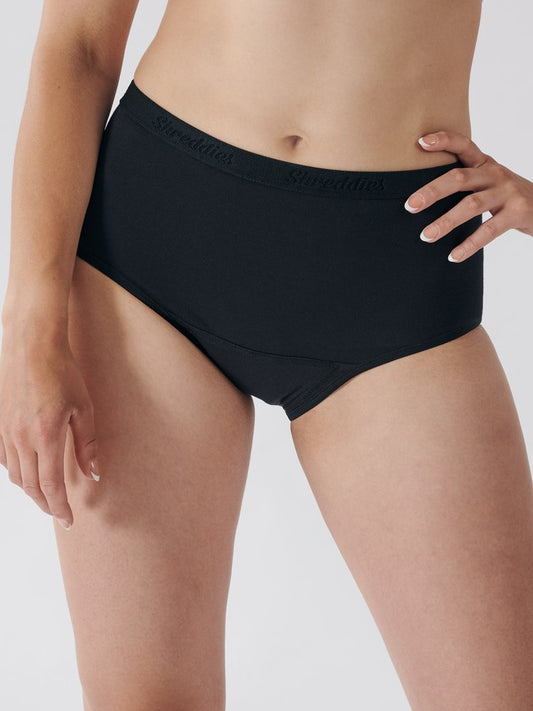
What is Bubble Gut? The Mortifying Truth About Your Digestive System's Worst Habit
Share
Picture this: You're crushing a presentation at work, feeling confident and professional, when suddenly your stomach starts performing what sounds like a symphony orchestra warming up—if that orchestra consisted entirely of broken wind instruments. The room goes quiet. Everyone's looking. And you're sitting there wondering if your intestines just declared war on your career prospects.
Welcome to bubble gut—the digestive phenomenon that has single-handedly ruined more quiet moments than a toddler with a megaphone. If you've ever felt like your abdomen is hosting its own percussion section, complete with unexpected solos and dramatic crescendos, you're experiencing one of humanity's most universal yet rarely discussed afflictions.
But what is bubble gut, really? Beyond the mortifying sound effects and uncomfortable pressure, bubble gut is your digestive system's way of announcing that something's gone awry in the complex ecosystem of your gut. It's like having a very rude orchestra member living in your intestines—one who plays off-key at the worst possible moments and seems to have zero respect for concert etiquette.
The truth is, bubble gut affects virtually everyone at some point, yet we've collectively decided to pretend it doesn't exist. We'll discuss the weather, politics, and our deepest fears before admitting that our stomachs occasionally sound like they're performing experimental jazz compositions. But ignoring bubble gut doesn't make it disappear—it just makes us more anxious when it inevitably strikes.
Understanding what causes this intestinal gas buildup and how to manage it can transform your relationship with your digestive system from adversarial to manageable. More importantly, recognizing that you're not alone in this gassy struggle is the first step toward reclaiming confidence in situations where your gut might have other plans.
What Does Bubble Gut Feel Like? Recognizing the Signs
Before diving into causes and solutions, let's identify what bubble gut actually feels like so you know if this describes your experience. Bubble gut symptoms can vary from person to person, but certain sensations are unmistakably characteristic of this digestive drama.
Physical Sensations
The hallmark feeling is that distinctive bubbling or churning sensation, like having carbonated soda actively fizzing inside your abdomen. You might feel actual gas bubbles moving through your intestines, creating a rolling or traveling sensation that can be surprisingly specific in location.
Many people describe feeling pressure waves that build and release, similar to contractions but specifically related to gas movement. The abdominal distension can make you feel like you've suddenly gained weight in your midsection, with clothes feeling tighter around your waist even when you haven't overeaten.
Auditory Announcements
Your stomach might produce sounds ranging from gentle gurgling to dramatic rumbling that seems disproportionately loud in quiet environments. These intestinal gas sounds often come in waves, sometimes building to crescendos that make you grateful for background noise.
The timing of these sounds is notoriously unpredictable—they can happen during important meetings, romantic dinners, or any moment when silence would be golden.
Associated Discomfort
Sharp, stabbing pains that move around your abdomen as gas bubbles navigate the curves of your intestines are common. These abdominal gas pains often resolve immediately after gas release, which distinguishes them from other types of digestive discomfort.
You might also experience that uncomfortable feeling of incomplete evacuation—like there's still pressure that needs to be released even after passing gas.
What is Bubble Gut? Decoding Your Digestive System's Drama
Let's strip away the embarrassment and get technical for a moment. Bubble gut is essentially your intestines conducting a chaotic musical performance, complete with sound effects that would make a sound engineer weep. From a physiological standpoint, bubble gut occurs when intestinal gas accumulates in your digestive tract faster than your body can eliminate it naturally. This creates pockets of trapped gas that move through your intestines, causing the characteristic bubbling sensation and stomach gurgling sounds.
The Anatomy of Abdominal Gas Bubbles
Your digestive tract produces gas through several mechanisms. Normal digestion creates some gas as bacteria ferment undigested food particles in your colon. Additionally, you swallow air throughout the day while eating, drinking, talking, and even breathing, which can accumulate and contribute to digestive gas buildup.
Under normal circumstances, this gas moves through your system relatively smoothly and is released gradually without significant discomfort. But when something disrupts this natural flow—whether it's dietary choices, stress, medical conditions, or lifestyle factors—intestinal gas can accumulate and create the characteristic bubbling sensation.
Your digestive system is normally a well-orchestrated symphony of processes—food gets broken down, nutrients get absorbed, waste gets eliminated, and everyone plays their part beautifully. But sometimes this orchestra decides to perform experimental jazz instead of classical music, and that's when you get bubble gut.
Gas Bubble Formation Process
Gas bubbles form when production exceeds your body's absorption and elimination capacity. Under normal circumstances, your intestines absorb about 99% of the gas produced during digestion. When this system gets overwhelmed—whether by diet, stress, or other factors—gas accumulates in distinct pockets that create pressure waves as they move through your digestive tract.
Bubble Gut Symptoms and Severity Levels
Understanding the range of bubble gut symptoms can help you assess whether you're dealing with mild digestive gas or something that warrants professional attention.
Mild Bubble Gut:
Occasional bubbling sensations, gentle stomach gurgling, minor abdominal distension that resolves within a few hours, and manageable gas release that doesn't significantly impact daily activities.
Moderate Bubble Gut:
More frequent bubbling sensations that interfere with concentration, noticeable abdominal gas pressure that affects clothing fit, digestive discomfort that impacts social situations, and intestinal gas that requires strategic timing around activities.
Severe Bubble Gut:
Constant abdominal pressure and bubbling, painful gas trapped in intestines, significant impact on work and social life, and symptoms accompanied by other concerning digestive issues.
When Normal Goes Rogue
Some gas production is completely normal—your body naturally produces about a liter of gas daily through various digestive processes. The average person releases gas 14-23 times per day, which is perfectly healthy. Bubble gut becomes problematic when intestinal gas production goes into overdrive, creating volumes that overwhelm your system's natural handling capacity.
The real issue isn't just physical discomfort—it's the unpredictability that creates anxiety, which can actually worsen symptoms.

The Science Behind Your Intestinal Gas Production
Understanding why your digestive system occasionally decides to audition for a sound effects role requires diving into the fascinating world of gut microbiology and digestive gas formation. Your intestines aren't just simple tubes—they're complex ecosystems hosting trillions of bacteria, each contributing to either healthy digestion or excessive gas production.
The Microbial Concert in Your Gut
Your large intestine hosts what scientists call the gut microbiome—a diverse community of bacteria, fungi, and other microorganisms that would make a major city look simple. These microscopic residents break down food your body can't digest, produce vitamins, and maintain immune function. However, they also create metabolic processes that produce gas.
When gut bacteria encounter complex carbohydrates that escaped digestion in your small intestine, they ferment them enthusiastically. This fermentation produces hydrogen, carbon dioxide, and methane gases, which accumulate and create the bubbling sensations characteristic of bubble gut.
The Perfect Storm Brewing
Bubble gut typically results when several factors align to create optimal conditions for gas overproduction. Poor digestion in your small intestine leaves extra fermentable material for your colon bacteria. Stress hormones alter gut motility, causing gas to accumulate rather than move efficiently. Changes in gut bacteria composition might favor gas-producing strains.
Gas bubbles form when production exceeds your body's absorption and elimination capacity. Your intestinal walls naturally absorb some gases into your bloodstream, where they're eventually exhaled through your lungs. When production overwhelms this system, gas accumulates in distinct pockets that create the bubbling sensation as they move through your digestive tract.
Individual Digestive Personalities
Not everyone's digestive system responds identically to the same foods or situations, which explains why your friend can eat beans without consequence while you turn into a gas factory. Genetic factors influence enzyme production, gut bacteria composition, and intestinal sensitivity. Some people naturally produce more gas, while others are more sensitive to normal amounts of intestinal gas.
These individual variations also explain why bubble gut triggers can be highly personal. What sends one person's digestive system into overdrive might barely register for another person. This individuality makes managing bubble gut both challenging and highly personal—what works for your friend might not work for you, and vice versa.
The Usual Suspects: What Triggers Your Digestive Drama
Identifying your personal bubble gut triggers is like being a detective investigating your own intestines. While individual responses vary wildly, certain categories of culprits consistently appear in digestive crime scenes.
The Food Felons
Some foods are virtually guaranteed to turn your digestive system into a gas-producing factory. Beans and legumes contain oligosaccharides—complex sugars your small intestine can't break down, leaving them available for enthusiastic bacterial fermentation.
Cruciferous vegetables like broccoli, cauliflower, and Brussels sprouts contain raffinose, another complex sugar that resists digestion. These vegetables are nutritional powerhouses, but they're also digestive anarchists.
Dairy products present a special challenge because lactose intolerance affects up to 75% of adults worldwide. Undigested lactose becomes premium fermentation fuel for colon bacteria, creating gas bubbles with impressive efficiency.
The Sneaky Saboteurs
Some bubble gut triggers hide in plain sight. Artificial sweeteners, particularly sugar alcohols like sorbitol and xylitol, sound healthy but are notorious gas producers. These compounds are poorly absorbed and rapidly fermented, creating gas bubbles that would make a champagne maker jealous.
Carbonated beverages literally introduce gas bubbles directly into your digestive system. While you might burp up some of this gas, significant amounts travel through your entire digestive tract, contributing to bubble gut sensations hours after consumption.
Even seemingly innocent foods can become triggers. High-fructose corn syrup can overwhelm your small intestine's absorption capacity, leaving excess fructose available for bacterial fermentation. Certain fruits like apples and pears contain both fructose and sorbitol, creating a double threat for sensitive digestive systems.
Lifestyle Accomplices
Your eating habits can be just as problematic as what you eat. Eating quickly prevents proper chewing, sending larger food particles to your colon where bacteria have more surface area to work with. Talking while eating increases air swallowing, literally inflating your digestive system with extra gas.
Chewing gum introduces both air and sugar alcohols, creating a perfect storm for bubble gut. Drinking through straws increases air intake, while eating large meals overwhelms your digestive system's processing capacity, leaving more undigested material for bacterial fermentation.
Stress-Induced Digestive Disruption
Modern life provides constant stress, which directly impacts digestive function through the gut-brain axis. Stress hormones alter gut bacteria composition, reduce digestive enzyme production, and slow intestinal motility. This creates conditions where food sits longer in your digestive system, providing extended fermentation opportunities for gas-producing bacteria.
Chronic stress also increases cortisol production, which can increase appetite for high-carbohydrate foods that happen to be excellent bubble gut triggers. This creates a cycle where stress causes you to eat foods that worsen digestive symptoms, which then creates more stress about potential embarrassment.
What Are Shreddies? Your Secret Weapon Against Bubble Gut
While addressing the root causes of bubble gut is crucial for long-term health, there's an immediate solution that can restore your confidence and eliminate the anxiety that often makes symptoms worse: Shreddies fart filtering underwear that neutralizes gas odors before they become social disasters.
Revolutionary Technology for an Ancient Problem
Shreddies USA has developed fart filtering underwear that uses activated carbon cloth to absorb and remove flatulence odors. Their patented products are specifically designed to provide freedom for sufferers of digestive disorders—or people who just fart a lot.
The activated carbon cloth filters flatulence odors using millions of microscopic pores that trap and neutralize odor molecules on contact. When gas passes through the fabric, the odor compounds are captured and eliminated before they can escape into the environment.
What makes this particularly revolutionary for bubble gut sufferers is that it addresses the anxiety component that often worsens symptoms. When you know you have reliable odor protection, you can reclaim your freedom and stop obsessively monitoring your digestive system.

Why Bubble Gut Sufferers Need This Technology
Bubble gut creates unique challenges because episodes are notoriously unpredictable in timing, volume, and intensity. Unlike some digestive issues that follow recognizable patterns, bubble gut operates on its own mysterious schedule, often choosing the most inconvenient moments to make dramatic announcements.
Shreddies provide several specific advantages for managing bubble gut-related anxiety:
Unpredictability Protection:
Since bubble gut episodes can occur without warning, having constant protection eliminates the mental energy spent trying to predict when you might need coverage.
High-Volume Confidence:
Bubble gut can produce impressive gas volumes that overwhelm traditional management strategies. Shreddies activated carbon cloth handles significant output effectively, providing confidence even during severe episodes.
Movement Freedom:
As gas bubbles travel through your digestive system, physical movement can trigger unexpected releases. Shreddies allow you to move naturally without worrying about the aromatic consequences.
Professional Confidence:
Whether you're in close quarters with colleagues, presenting to important clients, or networking at industry events, Shreddies eliminate the anxiety about accidental odor release that can undermine professional confidence.
Social Liberation:
Attend dinner parties, movie theaters, workout classes, or intimate gatherings without the constant mental calculation of gas timing and social consequences.
SHOP THE BEST UNDERWEAR FOR BUBBLE GUT

The Psychology of Protection
Beyond practical odor control, Shreddies offer profound psychological benefits that can actually improve digestive symptoms. The chronic worry about potential embarrassment creates stress that worsens bubble gut through the gut-brain axis. This creates a frustrating cycle where anxiety about gas makes gas worse, which increases anxiety about gas.
When you know you have reliable protection, several positive changes occur naturally. You can redirect mental energy from digestive monitoring to productive activities. You can engage more fully in social and professional interactions without reservation. You can experiment with beneficial foods or treatments without fear of social consequences during adjustment periods.
Seamless Integration into Daily Life
Shreddies are engineered for everyday wear, not just emergency situations. They're constructed from comfortable fabrics that feel like regular underwear while providing invisible protection. The activated carbon cloth maintains effectiveness through regular washing, making it a long-term solution rather than a temporary bandage.
For bubble gut sufferers, this means you can wear Shreddies as regular underwear, providing consistent confidence without needing to predict when symptoms might occur. They're particularly valuable for people managing IBS, Crohn's disease, colitis, food intolerances, or other digestive disorders during experimental phases of dietary changes, stress management efforts, or medical treatments.
Real-World Confidence Scenarios
Consider these common bubble gut challenges and how Shreddis transforms them from anxiety-inducing situations into manageable experiences:
Important Meetings:
Focus on presentations and strategic thinking instead of digestive monitoring and escape route planning.
Dating and Romance:
Enjoy intimate dinners and close physical proximity without the constant anxiety about digestive timing.
Travel Adventures:
Navigate airplane cabins, hotel accommodations, and unfamiliar environments with confidence rather than terror.
Exercise and Activities:
Maintain an active lifestyle without worrying that physical movement will trigger embarrassing gas releases.
Social Gatherings:
Attend family dinners, parties, and group events without strategic seating arrangements or constant bathroom mapping.
Dietary Experimentation:
Try elimination diets, add beneficial foods, or experiment with supplements without fear of social consequences during adjustment periods.
The Invisible Advantage
Perhaps most importantly, Shreddies are completely undetectable to others. They look and feel like regular underwear, with no bulk, noise, or obvious features that would indicate their special function. This invisibility is crucial for maintaining dignity and normal social interactions while managing bubble gut symptoms.
The psychological freedom of knowing you're protected, combined with complete discretion, allows you to reclaim control over your social and professional life. You can focus on long-term digestive health improvements without the paralyzing anxiety about immediate social consequences, creating space for actual healing rather than just symptom management.

Core Lifestyle Strategies
While Shreddies provide immediate confidence, addressing bubble gut's root causes requires comprehensive lifestyle changes. Many effective strategies are within your control and can provide significant relief with consistent implementation.
Mastering the Art of Strategic Eating
Timing your meals can dramatically impact bubble gut frequency and severity. Your digestive system operates on circadian rhythms, producing enzymes and adjusting motility based on expected eating patterns. When you eat randomly, this rhythm gets disrupted, leading to inefficient digestion and increased gas production.
Eating your largest meal earlier in the day capitalizes on peak digestive function, while avoiding large meals close to bedtime prevents gas from becoming trapped when you lie down. Spacing meals 3-4 hours apart allows complete digestion before introducing new food, reducing the accumulation of fermentable material in your colon.
The way you eat often matters more than what you eat for bubble gut management. Chewing thoroughly breaks down food particles, reducing bacterial fermentation opportunities. Eating slowly allows proper digestive preparation and reduces air swallowing. Minimizing distractions during meals improves digestion quality and reduces gas-producing inefficiencies.
Movement as Medicine
Regular physical activity serves as one of the most effective natural treatments for bubble gut. Exercise stimulates gut motility, helping trapped gas move through your system efficiently while improving overall digestive function. Even gentle walking can provide immediate relief during acute episodes.
Specific yoga poses offer targeted benefits for gas relief. Child's pose, knee-to-chest positions, and gentle spinal twists can help release trapped gas while improving digestive circulation. Many people find that 10-15 minutes of post-meal walking significantly reduces bubble gut symptoms by encouraging natural gas movement.
Stress Management for Digestive Peace
Since stress directly impacts gut function through the gut-brain axis, developing effective stress management techniques becomes essential for bubble gut control. Mental stress translates directly into digestive disruption, increasing gas production while reducing your ability to handle it effectively.
Daily stress-reduction practices like meditation, deep breathing exercises, or progressive muscle relaxation can activate your parasympathetic nervous system and improve digestive function. Even brief stress management sessions can provide measurable digestive benefits, making this one of the most cost-effective bubble gut treatments available.
Hydration Strategy
Proper hydration supports healthy digestion, but timing and temperature matter for bubble gut sufferers. Drinking plenty of water between meals supports overall digestive health, while limiting liquid intake during meals prevents digestive enzyme dilution. Room temperature water generally causes less digestive disruption than extremely cold or hot beverages.
Herbal teas offer additional therapeutic benefits—peppermint tea provides antispasmodic properties that reduce gas pain, while ginger tea improves digestive motility and can reduce nausea that sometimes accompanies severe bubble gut episodes.
Bubble Gut Trigger Foods: Quick Reference Guide
Understanding which foods contribute to intestinal gas and which ones provide relief requires recognizing that individual responses vary dramatically. Use this guide as a starting point for personal experimentation rather than universal rules.
High-Risk Bubble Gut Triggers
-
Beans and legumes: black beans, kidney beans, chickpeas, lentils, hummus
-
Cruciferous vegetables: broccoli, cauliflower, Brussels sprouts, cabbage, kale
-
High-FODMAP fruits: apples, pears, watermelon, stone fruits
-
Dairy products: milk, soft cheeses, ice cream (especially if lactose intolerant)
-
Carbonated beverages: soda, sparkling water, beer
-
Sugar alcohols: sorbitol, xylitol, mannitol (in sugar-free products)
-
Wheat products: bread, pasta, crackers (especially if gluten sensitive)
Safer Alternatives for Digestive Gas
-
Low-FODMAP fruits: bananas, oranges, grapes, strawberries
-
Gentle vegetables: carrots, zucchini, spinach, lettuce
-
Lean proteins: chicken, fish, eggs, tofu
-
Digestive-friendly grains: rice, quinoa, oats
-
Herbal teas: peppermint, ginger, chamomile
Strategic Timing for Trigger Foods
If you want to include gas-producing foods in your diet, timing matters significantly for managing bubble gut symptoms. Eat potentially problematic foods earlier in the day when digestive function is typically strongest and you have more time for complete digestion before sleep.
Avoid combining multiple high-FODMAP foods in single meals to prevent overwhelming your digestive system's processing capacity. Space trigger foods throughout the week rather than consuming them consecutively.
FAQ: Your Burning Bubble Gut Questions Answered
Q: What does bubble gut feel like compared to other digestive issues?
A: Bubble gut specifically involves the sensation of gas bubbles moving through your intestines, often with audible gurgling sounds and pressure that moves around your abdomen. Unlike general bloating, you can often feel distinct gas bubbles traveling through your digestive tract, and pain typically resolves immediately after gas release.
Q: How long does a bubble gut episode typically last?
A: Episodes can vary from 30 minutes to several hours, depending on the underlying cause. Gas from swallowed air usually moves through faster than gas from bacterial fermentation. Most people find relief within 2-4 hours through natural gas release or targeted relief techniques.
Q: Can bubble gut be a sign of a serious medical condition?
A: While bubble gut is usually benign, persistent or severe symptoms accompanied by unexplained weight loss, severe abdominal pain, changes in bowel habits, or blood in stool warrant medical evaluation. Conditions like SIBO, IBS, or inflammatory bowel disease can present with similar symptoms.
Q: Why does bubble gut seem worse at certain times of day?
A: Many people experience increased intestinal gas in the afternoon and evening due to accumulated food intake throughout the day, circadian changes in digestive function, and stress hormones that peak in late afternoon. Gas production from breakfast and lunch also reaches the colon around this time.
Q: Can certain medications cause bubble gut?
A: Yes, antibiotics can disrupt gut bacteria balance, proton pump inhibitors can affect digestion, and some supplements (especially those with sugar alcohols or high fiber) can increase gas production. Always consult healthcare providers about digestive side effects from medications.
Q: How quickly can I expect relief from dietary changes?
A: Individual responses vary dramatically. Some people notice improvement within days of eliminating trigger foods, while others may need several weeks to see significant changes. Gut bacteria composition changes can take 4-6 weeks, so patience is important when implementing dietary modifications.
Q: Do Shreddies really work for severe bubble gut episodes?
A: Shreddies are designed to handle significant gas output effectively using activated carbon cloth technology. The fart filtering underwear manages odor regardless of volume, providing confidence even during severe episodes. Many users report that knowing they have reliable protection actually reduces the anxiety that can worsen symptoms.
Q: Can bubble gut be completely cured?
A: While complete elimination might not be realistic for everyone, most people can achieve significant symptom reduction through comprehensive management strategies. The goal is typically managing symptoms to a level where they don't interfere with daily life rather than complete elimination.
Q: Are there any foods that are safe for everyone with bubble gut?
A: Individual responses vary so significantly that no foods are universally safe or problematic. However, white rice, bananas, and well-cooked lean proteins tend to be tolerated by most people. The key is identifying your personal triggers through careful observation and experimentation.
Q: How do I know if my bubble gut is severe enough to need medical attention?
A: Consider medical evaluation if symptoms significantly impact daily functioning, are accompanied by concerning symptoms like unexplained weight loss or blood in stool, or create severe anxiety that affects mental health. Your comfort and quality of life matter, and effective treatments are available.
Q: Can wearing Shreddies actually help reduce anxiety about digestive issues?
A: Yes, the psychological relief of knowing you have odor protection can significantly reduce anxiety, which in turn may improve digestive function since stress directly impacts gut health through the gut-brain axis. It's a positive cycle of confidence leading to better physical outcomes.
Q: Can exercise make bubble gut worse?
A: Exercise can temporarily increase gas movement, potentially triggering releases during physical activity. However, regular exercise generally improves digestive function and reduces bubble gut frequency over time. The key is finding activities you enjoy and using strategies like Shreddies to manage confidence during the adjustment period.
Disclaimer
This article is intended for informational and educational purposes only and should not be considered medical advice. The information provided is not intended to diagnose, treat, cure, or prevent any disease or medical condition. Individual responses to dietary changes, lifestyle modifications, and digestive symptoms vary significantly.
Bubble gut symptoms can sometimes indicate underlying medical conditions that require professional evaluation. If you experience persistent, severe, or concerning digestive symptoms, please consult with a qualified healthcare provider. This is particularly important if symptoms are accompanied by unexplained weight loss, severe abdominal pain, changes in bowel habits, or other worrying signs.
The information about Shreddies USA products is provided for educational purposes and does not constitute medical advice. While these fart filtering products may help manage odor-related concerns, they do not treat underlying digestive conditions.
Dietary recommendations and lifestyle suggestions should be considered general information rather than personalized advice. Individual dietary needs and tolerances vary significantly, and what works for one person may not be appropriate for another. If you have known food allergies, medical conditions, or take medications, consult healthcare providers before making significant dietary changes.
Always prioritize professional medical guidance over information found online, and never discontinue prescribed treatments or medications without consulting your healthcare provider. If you experience severe or rapidly worsening digestive symptoms, seek immediate medical attention.
The psychological and social impacts of digestive symptoms are real and valid. If bubble gut or related anxiety significantly affects your mental health or quality of life, consider speaking with mental health professionals who can provide appropriate support and treatment strategies.




